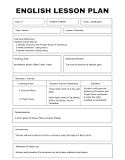
The Importance of a Well-Structured Lesson Plan
Lesson planning is a crucial aspect of effective teaching. A well-structured lesson plan serves as a roadmap for teachers, guiding them through the instructional process and helping to ensure that learning goals are met.
Here are some key reasons why having a well-thought-out lesson plan is essential:
- Clarity: A detailed lesson plan provides clarity on what needs to be taught and how it will be taught. This helps teachers stay focused and organized during instruction.
- Alignment: A lesson plan ensures that instructional activities align with learning objectives and educational standards, helping to promote coherence in the curriculum.
- Engagement: By incorporating various teaching strategies, resources, and activities into the lesson plan, teachers can keep students engaged and interested in the learning process.
- Assessment: Lesson plans often include formative and summative assessment strategies, allowing teachers to evaluate student progress and adjust instruction as needed.
In conclusion, a well-structured lesson plan is an invaluable tool for educators. It not only helps teachers deliver effective instruction but also enhances student learning outcomes. By investing time in thoughtful lesson planning, educators can create engaging and meaningful learning experiences for their students.
Essential Elements and Steps for Crafting an Effective Lesson Plan
- What are the 7 C’s in a lesson plan?
- What are the 5 steps in a lesson plan?
- What are the 5 parts of a lesson plan?
- How do I write my lesson plan?
What are the 7 C’s in a lesson plan?
In the context of lesson planning, the 7 C’s refer to key elements that can help educators create effective and engaging lessons. The 7 C’s typically include clarity, coherence, connections, context, challenge, engagement, and assessment. By incorporating these elements into their lesson plans, teachers can ensure that their instruction is well-structured, aligned with learning objectives, and designed to promote student engagement and learning outcomes. Each of the 7 C’s plays a crucial role in guiding teachers through the planning process and facilitating meaningful and impactful instruction in the classroom.
What are the 5 steps in a lesson plan?
In a typical lesson plan, there are five essential steps that educators follow to ensure effective teaching and learning. These steps include: 1) Setting clear learning objectives that outline what students should know or be able to do by the end of the lesson, 2) Planning engaging instructional activities and resources that help students achieve the learning objectives, 3) Incorporating assessment strategies to measure student understanding and progress, 4) Differentiating instruction to meet the diverse needs of learners, and 5) Reflecting on the lesson afterward to evaluate its effectiveness and make adjustments for future teaching. By following these five steps, teachers can create well-structured lessons that promote student engagement and achievement.
What are the 5 parts of a lesson plan?
In educational settings, a well-organized lesson plan typically consists of five key components. These components include the introduction, where the teacher sets the stage for the lesson and establishes its relevance to the students; the objectives, which outline what students are expected to learn by the end of the lesson; the instructional activities, which detail how the content will be presented and explored; assessment strategies, which allow teachers to gauge student understanding and progress throughout the lesson; and finally, a conclusion that wraps up the lesson and reinforces key concepts. By incorporating these five essential parts into their lesson plans, educators can create structured and effective learning experiences for their students.
How do I write my lesson plan?
When approaching the task of writing a lesson plan, it is important to start by clearly outlining the learning objectives you want to achieve. Consider the content you will be teaching, the instructional strategies you will use, and any materials or resources needed. Structure your lesson plan in a logical sequence, including an engaging introduction, main instructional activities, and a conclusion that reinforces key concepts. Be sure to incorporate assessment strategies to measure student understanding and make any necessary adjustments to your plan. Remember that flexibility is key – be prepared to adapt your lesson based on student responses and needs. By following these steps and staying organized, you can effectively write a comprehensive and effective lesson plan.
